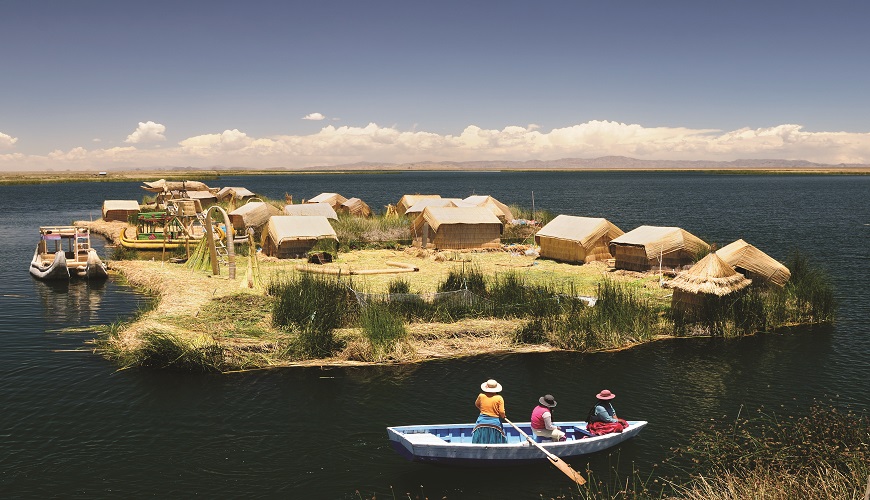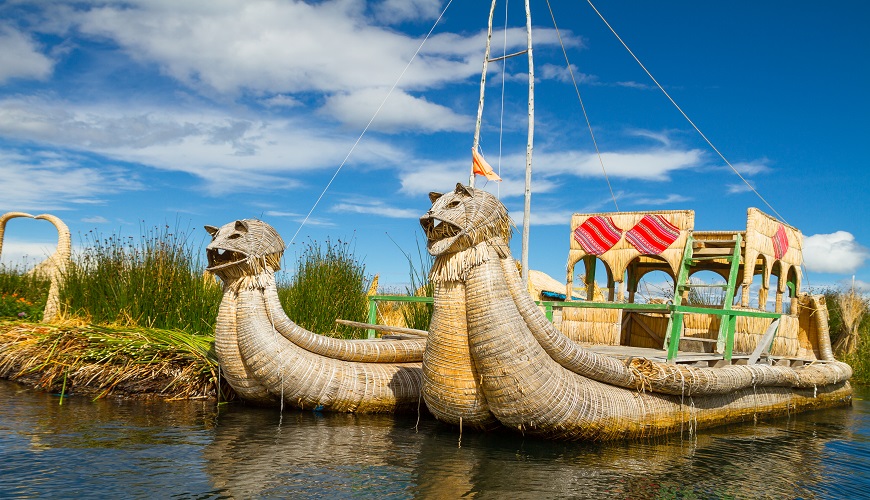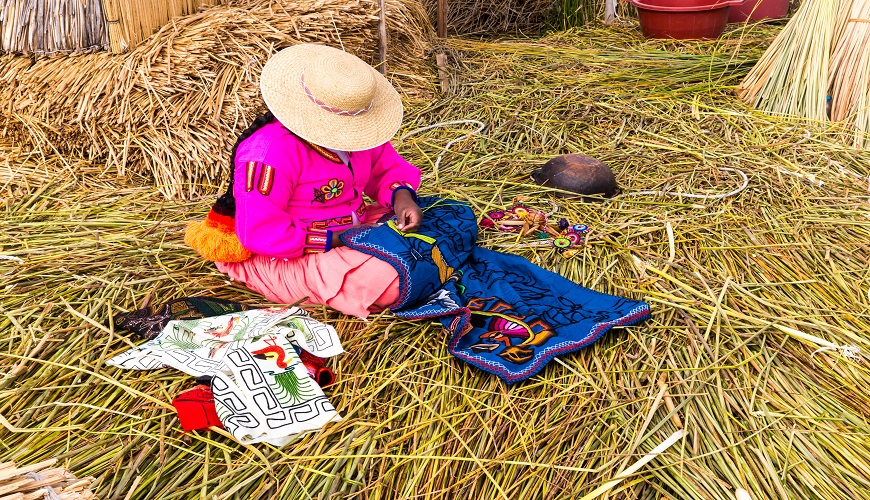The Inca believed Lake Titicaca to be the birthplace of the sun. When you look at the stunning scenery of the lake, it is easy to understand why. We have compiled some of the answers for frequently asked questions when planning a trip to Lake Titicaca.
How big is Lake Titicaca?
At over 8000 square kilometers Lake Titicaca is the largest lake in South America and, at an altitude in excess of 3,800 metres, the highest navigable lake in the world. The lake has Peruvian and Bolivian shores with approximately 60% of the lake in Peru and 40% in Bolivia and is fed by Ramis, Coata, Ilave, Huancane and Suchez river systems.

Wait – how high?
That’s right, Puno is 3872 M above sea level and therefore it is more than the scenery taking your breath away. For those who have not acclimatised, the altitude can cause headaches, loss of appetite, nausea, vomiting, dizziness, fatigue, weakness or sleep disturbance. Our local tour guides are very experienced in helping our travellers to avoid, and if necessary, treat altitude sickness. Your guide may recommend taking it slowly, resting frequently, to drink a mate (tea) made out of coca leaves or chew coca tablets (sugary pastilles) to help with mild symptoms. Once your body gets used to the altitude, symptoms tend to go.
The high elevation also means that it can be cold at night, so remember to pack warm clothing.

What’s the weather like at Lake Titicaca?
Think mountains! Temperatures range from 8 degrees in December and January to a high of 26 degrees in July and August. Even on those balmy days, temperatures drop at night so remember to pack clothing appropriate to the time of year.
It is often more helpful to think dry and wet seasons rather than Summer or Winter. The dry season typically runs from June to August and the rainy season December to February. If the rain isn’t your thing, you may want to avoid January which is the wettest month. To find out more, check out our guide on the best times to travel in Peru here.
Do the the islands on Lake Titicaca float?
Well, some of them do. There are over 50 floating islands in total, constructed from Totora reeds known as the Uros Islands . Many of the islands are tethered together and moored to the lake bed using long sharp sticks and plenty of rope (the lake is only about 600 feet at its deepest). Many floating islands have reed houses on top with room inside and out for the family and their animals to live.
Until the mid 1980s, most of the Uros islands were located just far enough from shore that few visitors visited them. In 1986, a storm devastated the islands and forced many Uros to rebuild closer to shore, making them accessible from Puno. Island constructions are thought to last up to 30 years, though the reeds need swapping out every three months or so.
Don’t be put off by the solar panels. The blogosphere is alive with debate about whether or not the Uros floating islands are authentic. Embracing modern technology has helped the Islander’s to remain connected to family and friends, access education and healthcare. All of these help to sustain their way of life, not diminish it.
And imagine.. if you ever get bored of your neighbours, you can cut your island free and sail away….

Don’t want your islands to float ?
Many of our tours offer the opportunity to visit Taquile and Amantani, beautiful islands on Lake Titicaca accessible by boat from Puno. Both islands offer the opportunity to experience local Aymara hospitality in unique and friendly homestays.
In 2005 Taquile unique textile art was recognised by UNESCO as a Masterpiece of the Oral and Intangible Heritage of Humanity. Knitting is traditionally an activity performed by the Taquileños men.
Amantani has two mountain peaks what are well worth the climb as they have ancient Inca ruins at the top of both.
Whether you choose the floating islands or to have your feet on the solid ground of Taquile and Amantani, , don’t forget they all lie at a high altitude. Walking can be tiring and carrying unnecessary bags will increase your workout. Carry only essentials with you such as sunscreen, water and of course, your camera.
Love to shop? We have that covered
You will be able to buy beautiful handcrafted knitted and woven items from the islanders you visit. These include bags, hats and the colorful chumpis, the wide belts with woven designs worn by everyone in the community. The textile patterns are traditional, vibrant and , with UNESCO recognition, considered to be among the highest-quality handicrafts in South America and the world.
Lake Titicaca has been inhabited for thousands of years, and recent research has uncovered evidence of objects being thrown into the lake as offerings to the Gods. If you are lucky enough to uncover ancient artifacts be mindful that it is illegal to take these items out of the country.

I love my food! What can I look forward to?
For some people, the opportunity to try new food is one of the best things about travelling! The lake provides a ready supply of fish such as corvina, trout and catfish. No trip to Peru would be complete without Lomo Saltado, an aromatic dish of beef, onions, chillies and tomatoes served with rice and fries. If you are a vegetarian travelling in Peru, then don’t worry! Quinoa is a staple, and other vegetarian food is readily available. Quinoa soup and papas fritas (french fries) are served as a side to just about every dish. For more information on the different food in Peru, check out our guide here!
Is there unique flora and fauna to see?
The lake and surrounding countryside is rich with flowers, plants and wildlife. You may be lucky enough to catch sight of Telmatobius culeus, commonly known as the Titicaca water frog. They are not small, at 50 cm long and weighing in at as much as 1kg . Nor are they considered very pretty, being nicknamed the “scrotum frog”. But, they are unique to the lake and very special. The frog is listed by the Convention on International Trade in Endangered Species of Wild Fauna and Flora as a species threatened with extinction.
In 1978 the Titicaca Reserve was created to help preserve the native flora and fauna including the water frog. There are 60 species of birds, 14 species of fish and 18 species of amphibians in the Reserve. Interested in the wildlife of Peru? Check out our comprehensive guide of wildlife in Peru.
How do I get there?
Tucan Travel have over 15 separate group tours and a number of Tailor-made Tours that include a day trip to this beautiful location. With tours from 11 to 55 days and tours options from Argentina, Brazil, Chile, Ecuador , Patagonia as well as Bolivia and Peru , it has never been easier to get to Lake Titicaca.
All of our tours that include Lake Titicaca, depart from and return to Puno. Puno is an atmospheric city of Peru resting on the shores of Lake Titicaca and is also the capital of the region of the same name.
Final tip...Taking photographs is a must on any adventure, and a trip to Lake Titicaca is no exception. Whilst most people are friendly and accommodating to travellers, it is always courteous to ask before taking anyone’s photograph.
About the Author
Tanya Clover works as a freelance copywriter for Tucan Travel. Tanya’s passions are travel, reading and horses. She has recently returned from 2 years working in Australia, where she travelled extensively. She has travelled in India, Thailand, North and Eastern Africa, Egypt and Peru. Travels in Europe have included Romania, Bulgaria, Norway, Northern Ireland, Ireland and Italy. Her favourite destinations last year were Egypt and Jordan. Follow Tanya on twitter @tancloverkent and Instagram @tandealkent

